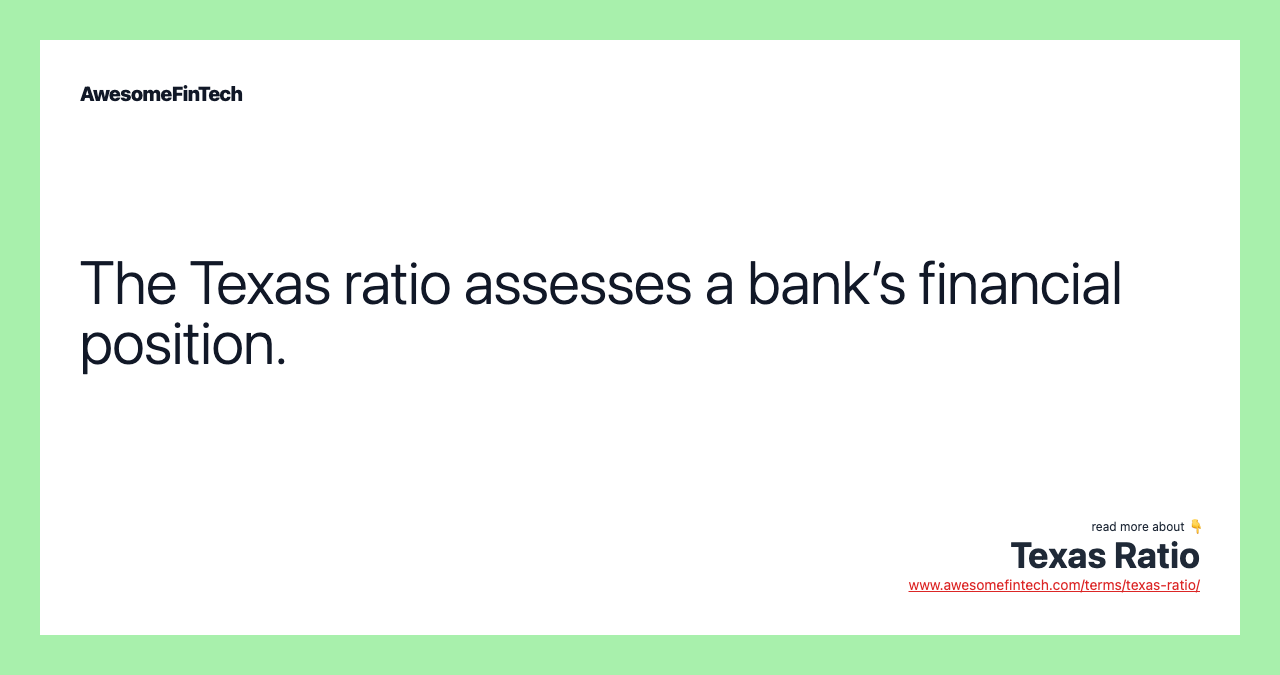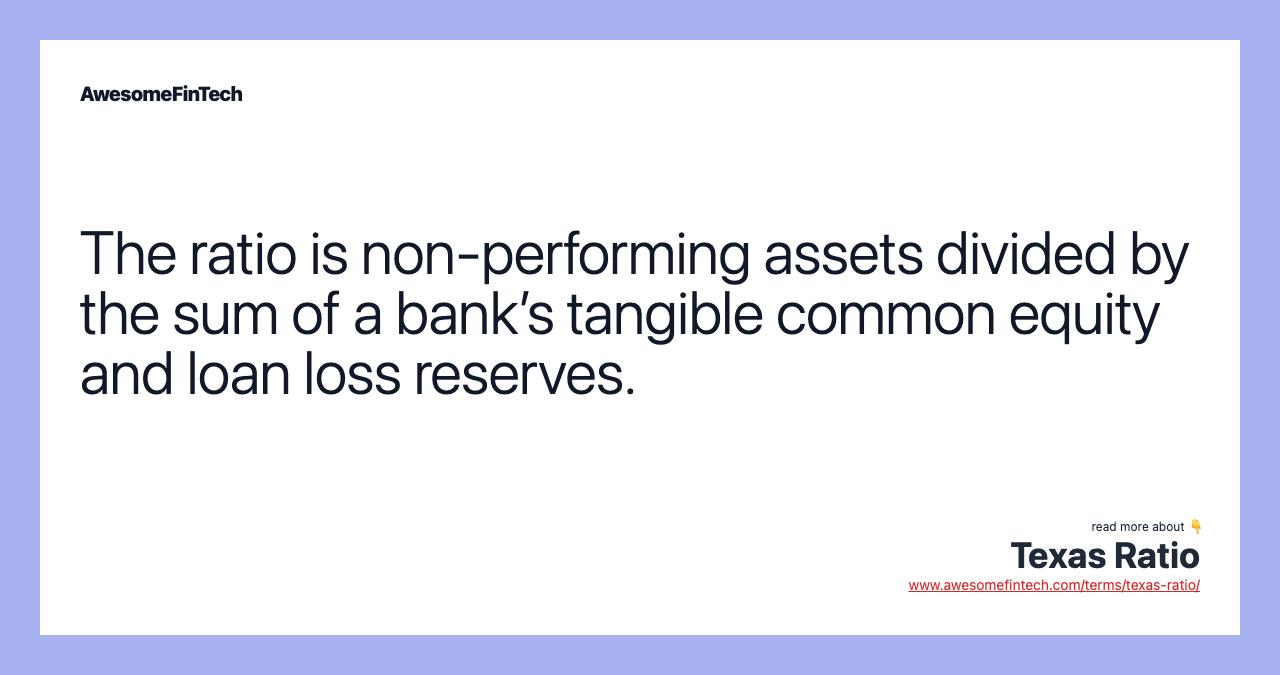Texas Ratio
The Texas ratio was developed to warn of credit problems at particular banks or banks in particular regions. The Texas ratio takes the amount of a bank's non-performing assets and divides this number by the sum of the bank's tangible common equity and its loan loss reserves. As part of the Texas ratio, non-performing assets include loans that are in default or real estate the bank has had to foreclose on. The ratio is non-performing assets divided by the sum of a bank’s tangible common equity and loan loss reserves. A high ratio doesn’t mean the bank will go bankrupt, as many banks can operate with high Texas ratios.

What Is a Texas Ratio?
The Texas ratio was developed to warn of credit problems at particular banks or banks in particular regions. The Texas ratio takes the amount of a bank's non-performing assets and divides this number by the sum of the bank's tangible common equity and its loan loss reserves. A ratio of more than 100 (or 1:1) indicates that non-performing assets are greater than the resources the bank may need to cover potential losses on those assets.




How the Texas Ratio Works
The Texas ratio was developed as an early warning system to identify potential problem banks. It was originally applied to banks in Texas in the 1980s and proved useful for New England banks in the early 1990s. The Texas ratio was developed by Gerard Cassidy and other analysts at RBC Capital Markets. Cassidy found that banks with a Texas ratio of greater than 100 tend to fail.
During the 1980s Texas saw an energy boom. Banks financed the surge, but soon the oil surge died down and banks started to struggle. As a result, Texas saw the greatest number of bank failures from 1986 to 1992 in the nation.
As part of the Texas ratio, non-performing assets include loans that are in default or real estate the bank has had to foreclose on. These could become expenses for the bank. On the other side, tangible equity does not include intangibles that cannot be used to cover losses, such as goodwill.
Special Considerations
The Texas ratio is useful for investors as well as customers. Banking customers will assess the Texas ratio to ensure their money is safe. This is especially important if a customer has money outside the Federal Deposit Insurance Corporation (FDIC) coverage limits — $250,000.
The Texas ratio, like many financial ratios, is best utilized with other analyses. A high ratio doesn’t mean the bank will go bankrupt, as many banks can operate with high Texas ratios.
Example of the Texas Ratio
A bank has $100 billion in non-performing assets. The bank’s total common equity is $120 billion. The Texas ratio is calculated as non-performing assets divided by tangible common equity. The ratio is 0.83 or 83%, or $100 billion / $120 billion. Although this is somewhat high, it’s best to look at the ratio in the historical context. Is the ratio rising or falling? If it’s falling then the bank may have a solid plan for keeping non-performing assets in check.
There are a number of banks right now (as of March 2020) that have Texas ratios of over 100%. This includes First City Bank in Florida with a 646.6% Texas ratio and The Farmers Bank in Oklahoma at 134.0%. Both of these banks have assets between $75 and $150 million.
Related terms:
Risk-Adjusted Capital Ratio
The risk-adjusted capital ratio is used to gauge a financial institution's ability to continue functioning in the event of an economic downturn. read more
Debt Ratio
The debt ratio is a fundamental analysis measure that looks at the extent of a company’s leverage. read more
Federal Deposit Insurance Corporation (FDIC)
The Federal Deposit Insurance Corporation (FDIC) is an independent federal agency that provides insurance to U.S. banks and thrifts. read more
Liquidity Coverage Ratio (LCR)
Liquidity Coverage Ratio (LCR) is a requirement under Basel III whereby banks are required to hold enough high-quality liquid assets to fund cash outflows for 30 days. read more
Liquidity Ratio
Liquidity ratios are a class of financial metrics used to determine a debtor's ability to pay off current debt obligations without raising external capital. read more
Loss Reserve
Typically comprised of liquid assets, loss reserves are an asset that allows an insurer to cover claims made against policies it underwrites. read more
Non-performing Asset (NPA)
A non-performing asset refers to loans or advances that are in jeopardy of default. read more
Tangible Common Equity (TCE) Ratio
The tangible common equity (TCE) ratio measures a firm's tangible common equity as a percentage of the firm's tangible assets. read more
Tangible Common Equity (TCE)
Tangible common equity (TCE) is a measure of a company's capital, which is used to evaluate a financial institution's ability to deal with potential losses. read more
Total-Debt-to-Total-Assets Ratio
Total-debt-to-total-assets is a leverage ratio that shows the total amount of debt a company has relative to its assets. read more